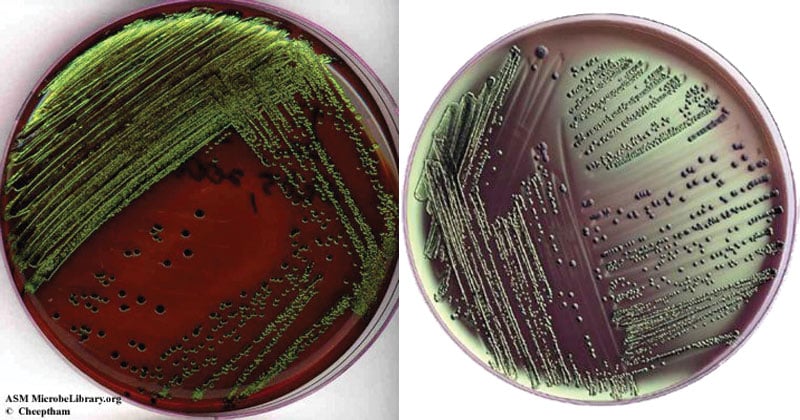- Eosin Methylene Blue (EMB) agar is a differential microbiological medium, which slightly inhibits the growth of Gram-positive bacteria and provides a color indicator distinguishing between organisms that ferment lactose (e.g., E. coli) and those that do not (e.g., Salmonella, Shigella).
- EMB agar was originally devised by Holt-Harris and Teague and further modified by Levine.
- It is thus a combination of the Levine and Holt-Harris and Teague formulae which contains a peptic digest of animal tissue and phosphate as recommended by Levine and two carbohydrates as suggested by Holt-Harris and Teague.
- The medium is important in medical laboratories to distinguish gram-negative pathogenic microbes in a short period of time.

Interesting Science Videos
Composition of EMB Agar
| Ingredients | Gms/liter |
| Peptic digest of animal tissue | 10.000 |
| Dipotassium phosphate | 2.000 |
| Lactose | 5.000 |
| Sucrose | 5.000 |
| Eosin – Y | 0.400 |
| Methylene blue | 0.065 |
| Agar | 13.500 |
Final pH (at 25°C): 7.2±0.2
Principle of EMB Agar
- EMB agar is characterized by the presence of a combination of the two dyes eosin and methylene blue in the ratio of 6:1.
- Gram-negative bacteria that ferment the lactose produce acid which lowers the pH. This encourages dye absorption by the colonies and turns the colonies dark purple as the acid acts upon the dyes.
- In addition, certain lactose-fermenting bacteria produce flat, dark colonies with a green metallic sheen.
- Other lactose fermenters produce larger, mucoid colonies, often purple only in their center.
- In EMB agar, most of the strains of E. coli colonies have a characteristic green sheen. Rapid fermentation of lactose & production of strong acids, thus a rapid reduction in the pH of the EMB agar the critical factor in the formation of the green metallic sheen observed with E. coli, rapid fermentation of lactose and formation of strong acids.
- Lactose non-fermenters, on the other hand, may increase the pH by deamination of proteins. This ensures that the dye is not absorbed. The colonies will be colorless.
- Lactose non-fermenters are thus either colorless or light lavender.
- Peptic digest of animal tissue serves as a source of carbon, nitrogen, and other essential growth nutrients.
- Lactose and sucrose are the sources of energy by being fermentable carbohydrates.
- Eosin-Y and methylene blue serve as differential indicators. Phosphate buffers the medium.
Preparation and Method of Use of EMB Agar
- Suspend 35.96 grams in 1000 ml distilled water.
- Mix until the suspension is uniform. Heat to boiling to dissolve the medium completely.
- Sterilize by autoclaving at 15 lbs pressure (121°C) for 15 minutes. AVOID OVERHEATING.
- Cool to 45-50°C and shake the medium in order to oxidize the methylene blue (i.e. to restore its blue color) and to suspend the flocculent precipitate.
- Pour into sterile Petri plates.
- Allow plates to warm to room temperature.
- The agar surface should be dry before inoculating.
- Inoculate and streak the specimen as soon as possible after collection.
- If the specimen to be cultured is on a swab, roll the swab over a small area of the agar surface and streak for isolation with a sterile loop.
- Incubate plates aerobically at 35-37°C for 18-24 hours and protect from light.
- Examine plates for colonial morphology. If negative after 24 hours, reincubate an additional 24 hours.
Result Interpretation on EMB Agar
| Organisms | Growth |
| Escherichia coli | Blue-black bull’s eye; may have a green metallic sheen |
| Pseudomonas aeruginosa | Colorless |
| Enterobacter aerogenes | Good growth; pink, without sheen |
| Klebsiella pneumoniae | Pink, mucoid colonies |
| Proteus mirabilis | Luxuriant growth; colorless colonies |
| Salmonella Typhimurium | Luxuriant growth; colorless colonies |
Uses of EMB Agar
- EMB Agar (Eosin Methylene Blue Agar) is recommended for the isolation and differentiation of gram negative enteric bacteria from clinical and nonclinical specimens.
- It is useful in differentiating gram positive and gram-negative bacteria.
- It helps in the isolation and differentiation of enteric bacilli and gram-negative bacilli.
- It is used in testing the quality of water, especially in determining if the water is contaminated by harmful microorganisms.
- It differentiates microorganisms in the colon-typhoid-dysentery group.
- EMB media assists in visual distinction Escherichia coli, other nonpathogenic lactose-fermenting enteric gram-negative rods, and the Salmonella and Shigella genera.
- It also helps in the isolation and differentiation of lactose fermenting and non-lactose fermenting enteric bacilli.
Limitations of EMB Agar
- A non-selective medium should be inoculated in conjunction with EMB Agar.
- It is recommended that biochemical, immunological, molecular, or mass spectrometry testing be performed on colonies from pure culture for complete identification.
- Some strains of Salmonella and Shigella may fail to grow on EMB Agar.
- Some gram-positive bacteria, such as enterococci, staphylococci, and yeast will grow on this medium and usually form pinpoint colonies.
- Non-pathogenic, non-lactose-fermenting organisms will also grow on this medium. Additional biochemical tests must be performed in order to distinguish these organisms from pathogenic strains.
- Serial inoculation may be required to ensure adequate isolation of mixed flora samples.
- Some strains of E. coli may fail to produce a characteristic green metallic sheen; consequently, the green metallic sheen is not diagnostic for E. coli.
References
- https://laboratoryinfo.com/emb-agar-eosin-methylene-blue-agar/
- https://microbeonline.com/eosin-methylene-blue-emb-agar-composition-uses-colony-characteristics/
- http://himedialabs.com/TD/M317.pdf
- https://bio.libretexts.org/Ancillary_Materials/Experiments/Microbiology_Labs_I/23%3A_Eosin_Methylene_Blue_Agar_(EMB)

Lovely resource!
This is a very good site with relevant and well explained information.